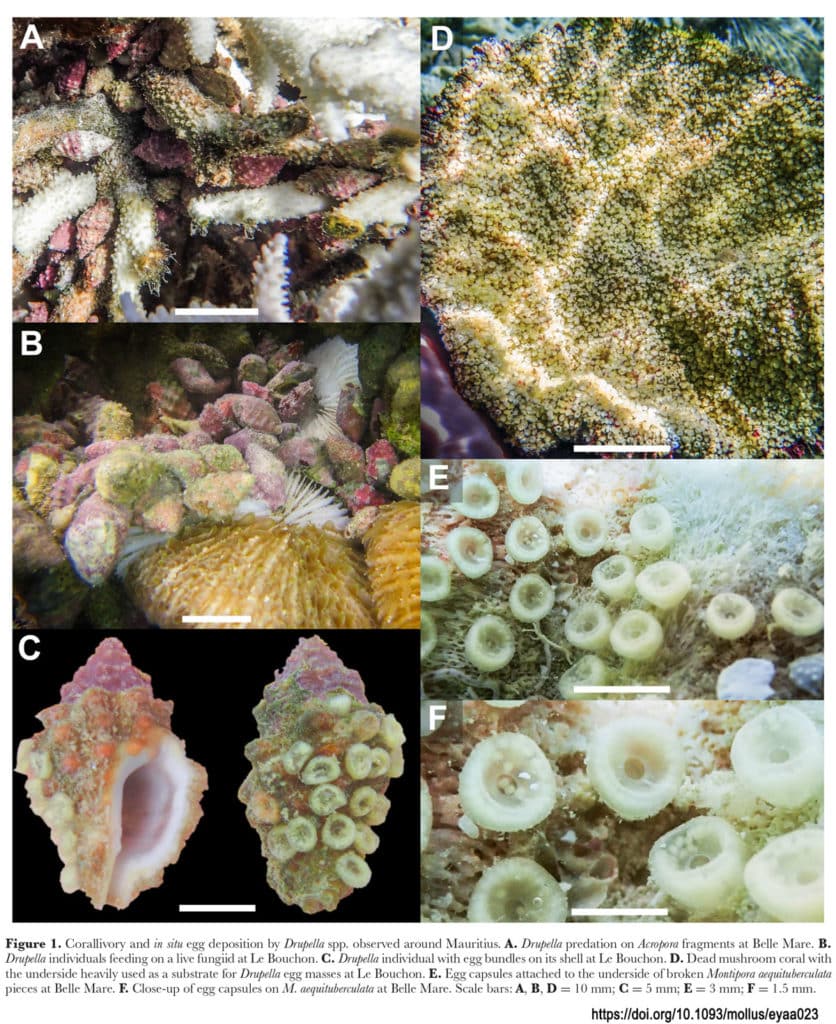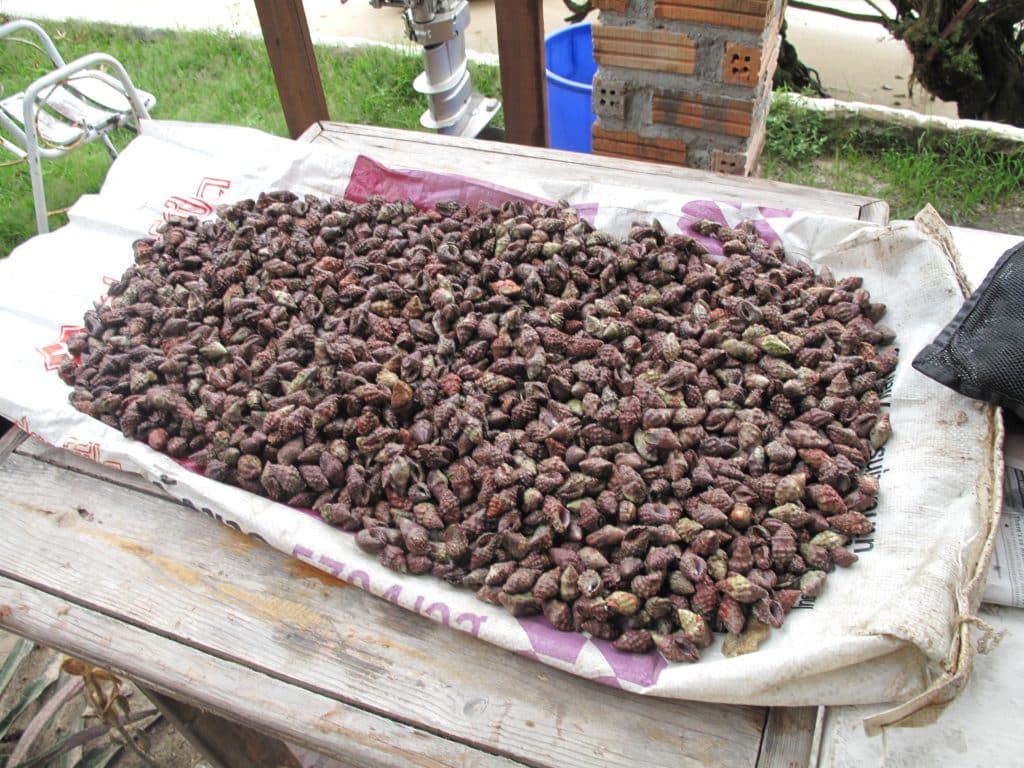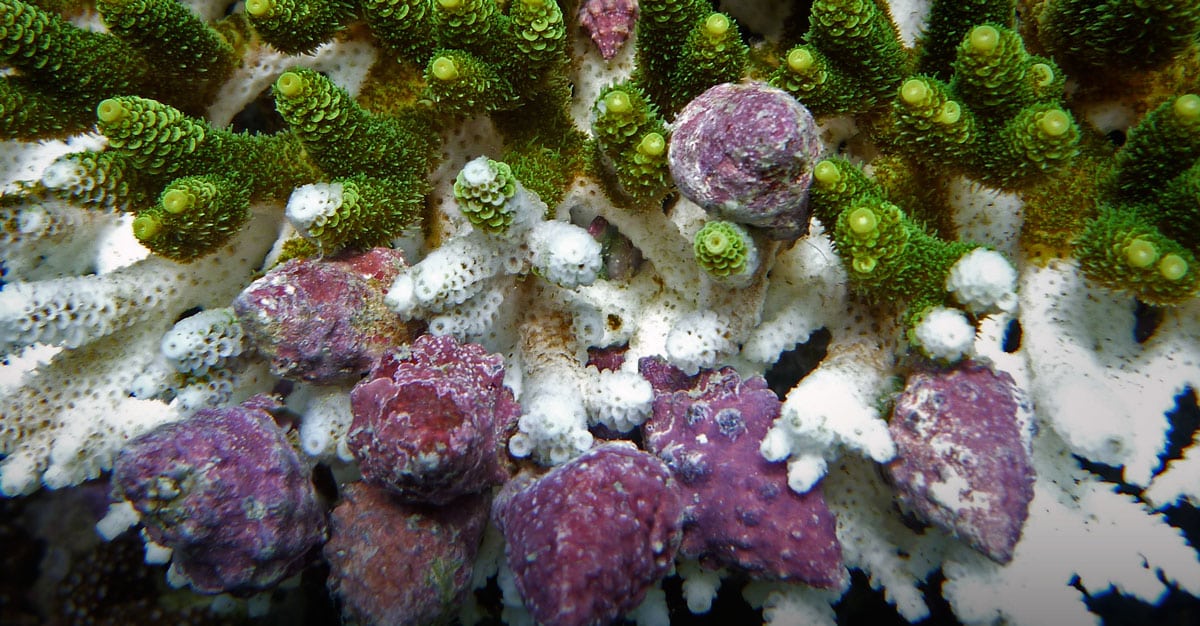Understanding Corallivorous Drupella Snails
Although outbreaks of corallivorous Drupella snails have been increasing across the Indo-Pacific since the 1980s, still very little is known about their reproductive ecology. These tiny snails can occur in great abundance and can contribute to reef decline by lowering the total abundance of living coral and changing the population structure of reef communities.

Tracking these Coral Predators
Conservation Diver has been focusing on Drupellas for some time, with our first observation of the snails shifting their preferred food sources following the global mass coral bleaching event of 2010. Since then, our partners at the New Heaven Reef Conservation Program have collected more than 179,740 Drupella snails from around the island of Koh Tao, with 76% coming from a single bay.
In 2019, a team of our Conservation Diver Trainers traveled to Mauritius for a collaborative research expedition with the University of Mauritius. They were pleased to apply their Drupella snail knowledge to the local reefs and assist published Drupella snail researcher Deepeeka Kaullysing, in recording observations from the area. During their biodiversity surveys, primarily focused on heterobranchs, they noticed a significant deposition of egg masses under mushroom corals in the vicinity of a large Drupella aggregation. Upon closer inspection, they realized they were looking at the largest concentration of Drupella egg clusters ever recorded.
Although the first outbreak of Drupella snails was recorded in the early 1980s, much of what we understand about their life history is derived from similar organisms. Very few publications detail observations of the egg or larval stage of these predators, which is vital to know to mitigate the damage caused by over-populations or outbreaks.
Understanding Drupella Lifecycles
The first recorded Drupella egg deposition was published by Sam et al. in 2016 in an aquarium. This was followed quickly by the first in situ observation in 2017 by Scott et al. and was also the first record of egg deposition on the underside of Fungiidae corals.

The recent Kaullysing et al. (2020) publication is the first record of Drupella egg deposition in Mauritius and the Western Indian Ocean. Additionally, this is the first record of in situ egg deposition on corals other than Fungia. This time, eggs were observed on Fungia, Montipora, and the shell of another Drupella snail.
Furthermore, it represents the highest abundance of corallivorous Drupella eggs ever observed, with 5,020 egg bundles on a single coral (each bundle contained approximately 96 embryos).

Observations such as these are vital to the understanding of the ecology and life history of these cryptic species. Only 40 years ago, they were essentially unheard of, yet today they are seen as one of the Indo-Pacific's significant problematic coral predators.
Stopping Outbreaks of Drupella
To halt outbreaks and mitigate their damage, reef managers must understand the details of their life history. By targeting benthic egg cases for removal rather than the adults, much time and resources could be saved.
The program on Koh Tao has been working for a decade to remove nearly 180,000 adult snails, whereas removing just the observed corals in Mauritius could potentially prevent the dispersal of 1.6 million embryos (4 corals x 5,000 egg bundles each x 80 embryos per egg bundle).

This is a very important publication for the advancement of this field and surely will be one of the stones placed on the path to better understanding and management guidelines for these pervasive coral predators. We wish our sincerest gratitude and congratulations to all of the authors, but especially those on the Conservation Diver team; Rahul Mehrotra, Spencer Arnold, Alyssa Allchurch, and Elouise Haskin.
Be sure to check out the paper here
Coral Predators Monitoring & Monitoring
Coral Predators Monitoring & Management

The Coral Predators Monitoring and Management Course is designed to give students an introduction to the impacts of over-populations or outbreaks of coral predators such as the Crown of Thorns starfish and Drupella Snails. The course teaches students about the causes and effects of imbalances in the reef ecosystem, and gives them the knowledge and skills to monitor and assess coral predator populations. In addition to learning about ways to address the root of the problem, students will also learn how to safely and effectively manage populations of coral predators to increase reef resilience, decrease mortality following bleaching events, and be proactive in managing coral reef areas for future sustainability .




Prerequisites
- Be 12 years of age or older
- Be certified as an Advanced diver under a leading diving organization (PADI, SSI, RAID, etc) or an Open Water diver who has satisfactorily completed a buoyancy appraisal with a professional diver
- Demonstrate proper diving ability at an advanced Level and be proficient in buoyancy and self-awareness
- Be certified in our Ecological Monitoring Program
Standards
- Understand the role coral predators play in the ecosystem
- Understand current theory on population dynamics of coral predators in stressed reef ecosystems
- Learn about the root causes of coral predator population outbreaks
- Understand the life-history and reproductive strategies of organisms such as Drupella Snails and Crown of Thorns Starfish
- Learn how to safely and effectively manage populations of coral predators
- Practice assessing coral predator abundance and managing populations
Requirements
- Attend the lecture on coral predators
- Perform a coral predator population survey
- If research suggests a local outbreak then perform a predator management and removal dive
Expected course time about 6 hours
Certification Card

Training Centers
Published Papers and reports Related to this course
- Population dynamics of corallivores (Drupella and Acanthaster) on coral reefs of Koh Tao, a diving destination in the Gulf of Thailand by Chad M. Scott, Rahul Mehrotra, Margaux Y. Hein, Michelangelo S. Moerland, and Bert W. Hoeksema
- In-situ egg deposition by corallivorous snails on mushroom corals at Koh Tao (Gulf of Thailand) by Chad M. Scott, Rahul Mehrotra and Bert W. Hoeksema
- Prey selection of corallivorous muricids at Koh Tao (Gulf of Thailand) four years after a major coral bleaching event by Michelangelo S. Moerland, Chad M. Scott and Bert W. Hoeksema
- Spawning observation of Acanthaster planci in the Gulf of Thailand by Chad M. Scott, Rahul Mehrotra and Pau Urgell Plaza
- Dietary shift in corallivorous Drupella snails following a major bleaching event at Koh Tao, Gulf of Thailand by B.W. Hoeksema, C. Scott & J.D. True


